Abstract
Emerging consumer devices rely on the next generation IoT for connected support to undergo the much-needed digital transformation. The main challenge for next-generation IoT is to fulfil the requirements of robust connectivity, uniform coverage and scalability to reap the benefits of automation, integration and personalization. Next generation mobile networks, including beyond 5G and 6G technology, play an important role in delivering intelligent coordination and functionality among the consumer nodes. This paper presents a 6G-enabled scalable cell-free IoT network that guarantees uniform quality-of-service (QoS) to the proliferating wireless nodes or consumer devices. By enabling the optimal association of nodes with the APs, it offers efficient resource management. A scheduling algorithm is proposed for the cell-free model such that the interference caused by the neighbouring nodes and neighbouring APs is minimised. The mathematical formulations are obtained to carry out the performance analysis with different precoding schemes. Further, the allocation of pilots for obtaining the association with minimum interference is managed using different pilot lengths. It is observed that the proposed algorithm offers an improvement of 18.9% in achieved spectral efficiency using partial regularized zero-forcing (PRZF) precoding scheme at pilot length . In the end, the performance comparison with two other models incorporating random scheduling and no scheduling at all is carried out. As compared to random scheduling, the proposed scheduling shows improvement of 10.9% in obtained spectral efficiency by 95% of the user nodes.
1. Introduction
The Internet of things (IoT) has changed the way we interact with and use our devices. It has a significant impact on the consumer electronics. IoT offers connectivity, automation, integration, personalization to the proliferating consumer devices. The functionality and efficiency of consumer devices, communication nodes, sensor nodes, mobile terminals is highly dependent on the next generation of IoT, which needs to be robust, intelligent and secure. Next generation IoT offers connected support to the consumers for personalized experience. But with the growing number of IoT devices comes challenges. Network congestion, reduced network speed, security risks, interoperability issues, compatability issues, data management, and battery management are the major challenges [1]. The power consumption or the energy overhead of the battery-powered IoT devices or consumer nodes led to severe energy crisis in next generation IoT network. For this, energy-efficient network designs coupled with energy harvesting techniques are required to offer sustainable solutions for next-gen IoT [2]. The heterogeneous IoT networks need to perform seamlessly, for which dynamic network frameworks are needed to support interoperability, integration and coordination [3]. Owing to the increasing number of IoT nodes and communicating terminals, the storage and security of the huge data are a challenge. The vulnerability of IoT devices and data to various threats require robust security mechanisms [4]. To overcome these challenges and to equip the next generation of IoT devices with powerful computing capabilities, intelligent decision-making, and better data management and security, future wireless technologies play an important role [5]. The sixth generation (6G) technology with extended fifth generation (5G) capabilities, offers high data rates, reduced latency and ultra-high reliability [6,7]. Multiple-antenna technologies [8], intelligent reflecting surfaces (IRSs) [9], heterogeneous networks (HetNets) [10], millimetre wave (mmWave) technology [11] are the breakthrough technologies of beyond 5G and 6G. The channels in 6G wireless networks involve non-stationarity, uncertain wireless propagation and high-mobility which require efficient modelling and characterisation for improved performance evaluation [12]. The channel measurements for different 6G wireless scenarios are different for all frequency bands [13]. MmWave technology suffers from shorter wavelengths and large signalling overhead [14,15] while HetNets cannot result in increased data rates after a certain cell density. Cell-free massive multiple-input–multiple-output (MIMO) is a key 6G technology that provides connected support to the communicating user nodes. With the help of multiple access points (APs) large number of nodes are being served by removing the cell boundaries such that the cell-edge traffic congestion is eliminated [16]. By distributing the radio access among multiple APs, it enhances network coverage, supports network scalability and reduces latency [17]. Through the cooperative processing capabilities of APs, it enables decentralisation such that the fault tolerance and network resilience is improved [18]. The 6G enabled cell-free network supports proliferating connected devices in the network with the help of cooperating APs, and thus is scalable [19]. This is different from MIMO and massive MIMO, which provide coverage to the nodes within the cell boundaries serviced by a centrally placed multi-antenna base station (BS) [20,21]. These suffer from the drawbacks of inter-cell interference, cell-edge traffic congestion and call drops owing to handovers [22]. The main idea of cell-free massive MIMO is to deploy large number of APs in a given coverage area to provide network connectivity and support to the IoT nodes [23]. The APs cooperate among themselves in order to serve the communicating nodes such that the network performance is enhanced [24,25]. The APs are connected through cloud processors called central processing units (CPUs) [26]. There are different network operations of cell-free systems, namely distributed and centralized. The signal processing takes place at the CPU in centralized operation where the AP acts as remote relays and send the information to the CPUs for processing [27]. In distributed operation, all the signal processing takes place at the AP. In order to provide stringent quality-of-service (QoS) to all the user nodes, a cell-free approach is used. It allows the coordination of a large number of distributed APs in a given coverage area for serving the enormous wireless devices [28]. Cell-free systems with single antenna nodes and APs are evaluated for performance in [29] for spectral efficiency. It is observed that, by equipping multiple antennas at the APs in a cell-free framework, the spectral efficiency can be further increased [30,31,32]. The cell-free approach is used recently in an expanded IoT network to provide extended communication support to the wireless nodes [33]. It aims to propose a scalable IoT network powered by cell-free method such that the energy efficiency is maximized using suitable power control. The role of the cell free system in sustainable IoT networks is highlighted in [34], where the energy is harvested to reduce the total energy consumption. In cell-free IoT networks, the beamforming is used in [35] to maximise the achievable rate using simultaneous wireless information and power transfer (SWIPT). The literature gives the comparison of conventional massive MIMO system with cell-free massive MIMO system [36,37,38]. It is highlighted that cell-free approach is more suitable for offering massive connectivity and high energy efficiency. The use of distributed APs in cell-free systems against the collocated antennas in massive MIMO results in improved performance. Different propagation environments are considered to carry out the performance comparison; for example, [39] assesses the cell-free IoT network with the Rayleigh channel model in addition to [40,41]. The signal processing in cell-free networks and their performance evaluation are carried out in [42,43,44,45]. The transmit precoding is considered in [42,43], which also uses optimal allocation of training symbols to achieve cooperative clustering. The channel estimation in cell-free networks is highlighted in [44], which aims for better efficiency with reduced normalized mean square error (NMSE). The use of receive combiners in cell-free networks for data detection results in the maximum gain [45]. The role of beamforming for minimum system interference is explored in [46]. The optimization of power control algorithms in the uplink of cell-free IoT systems is considered in [47] with efficient scalability analysis [19]. To serve the massive IoT nodes, the main challenge in a cell-free network is to coordinate or manage the APs and nodes optimally. The cooperation among the APs for coherent transmission with the wireless nodes need to be planned in such a way that interference is reduced. The user access for resources and associated APs requires efficient coordination and optimization such that the network throughput is improved in massive access scenarios. The intelligent algorithms involved in the optimization problems are reviewed in [48] for various application domains. For a multi-UAVs assisted communication scenario, ref. [49] investigates a task reallocation mechanism using optimization algorithm.
In this paper, a cell-free IoT network is proposed to meet the massive access needs of the enormous wireless nodes. For efficient network performance, a scheduling algorithm is proposed such that the interference due to neighbouring nodes and APs is minimised. The scalable precoding schemes are used under different cell-free network operations for maximum achieved spectral efficiency. The proposed communication scenario with an interference-aware scheduling algorithm is compared with system network incorporating random scheduling.
Contributions and Outcomes
With the increasing number of IoT nodes, connected devices and the huge network traffic, the demand for seamless network connectivity has also increased. Thus, the need is to look for extended network capabilities in the future 6G wireless networks. This paper proposes a dynamic framework to offer massive connectivity in a 6G-enabled IoT network. The novel contributions of the paper are
- A cell-free IoT network is proposed that supports the enormous wireless nodes with uniform coverage and QoS.
- An interference-aware scheduling algorithm is proposed that offers optimal resource management by associating APs to the nodes optimally using designed pilot allocation.
- The mathematical formulations are obtained for the achieved spectral efficiency under different precoding schemes for different cell-free operations.
- The system is evaluated for performance in terms of spectral efficiency achieved for different number of communication nodes, pilot lengths and precoding methods.
- The proposed cell-free network with the proposed scheduling mechanism is compared with other system models, one incorporating random scheduling and other not incorporating any scheduling.
The rest of the paper is organised as follows. Section 2 defines the system model along with the mathematical formulations for pilot transmission, channel estimation and data transmission. The precoding schemes used for the proposed model are also explained in Section 2. Section 3 gives the scheduling mechanism adopted for the association of APs and nodes followed by the proposed algorithm. The results are presented in Section 4 with a detailed discussion. Section 5 concludes the paper, giving a direction for the future scope. Table 1 lists the summary of notations used throughout the paper.

Table 1.
Summary of notations.
2. System Model
In this section, an IoT-enabled communication scenario involving large number of user nodes is considered where their communication is assisted by large number of access points (APs). Suppose K be the number of user nodes and L be the number of APs in a given IoT network. The user nodes are assumed to be equipped with a single antenna while the APs have multiple N antennas. The communication framework is shown in Figure 1. It assumes a user-centric cell-free approach in which a set of APs serves a particular user node. Let define a subset of APs that serve a particular user node k such that and for every k and l

Figure 1.
Proposed communication scenario showing intended AP-node transmission affected by interfering nodes and interfering APs.
The communication model that supports the transmission between each AP and each node adopts the block fading channel where the channel coefficients between user k and AP l remain constant for each coherence block consisting of transmission symbols. The channel characteristics are estimated using uplink pilot training in the pilot transmission phase. The fading associated with the channels in each block is spatially correlated Rayleigh fading denoted as
are the independent and identically distributed channel elements drawn from Gaussian distribution with mean 0 and variance . Here, is the spatial correlation matrix, which is related with the large scale fading given by
The large scale fading includes path loss with exponent and shadowing denoted as [50]
with being the distance between AP l and user node k. The network operation is assumed in which the symbols of coherence block comprise of symbols for pilot training and for data transmission.
2.1. Pilot Transmission and Channel Estimation
In the proposed system scenario, a set of orthogonal pilot sequences of length is used to obtain the channel statistics. Since the number of user nodes K is more than the number of orthogonal pilot symbols , that is, , each user cannot be provided with a unique pilot. Thus, the pilots are shared among the user nodes. The nodes that share the same pilots are referred to as co-pilot nodes. Let us define representing a set of nodes allocated pilot t. Also, denotes the index of pilots allotted to node k. Each user node k transmits the pilot t with pilot transmit power . The signal received in this phase by the lth AP is given by
where, is the receiver noise such that . The user nodes in the set transmit the pilot which is received by the lth AP
In order to obtain the channel estimates , minimum mean square error (MMSE) estimation method is used [21]
where is the spatial correlation matrix which is equal to , is the correlation matrix of the received signal.
2.2. Data Transmission
For the data transmission in the downlink, AP l transmits the data to user node k, which is precoded using the precoder given below:
The precoder is selected such that . The role of precoder is to cancel the interference caused by the neighbouring user nodes. The transmission to the intended user may be interference to the other users. The interference can be mitigated using optimal precoding schemes [51]. In the centralized operation, all the signal processing including precoding is performed at the CPU, where interference can be cancelled by varying the transmit powers and phases of the transmitting APs. In distributed operation, where the signal processing takes place at the AP, suitable precoding schemes are used [52]. Let be the transmitted data signal intended for user node k. The signal received by user node k from the transmission of AP l is
where is the power AP l assigned to user node i with being the maximum transmission power of each AP in the downlink. Depending on the network operation, different transmit precoding methods or schemes can be used [39]. Two main schemes used in the distributed operation are maximal ratio (MR) precoding and local partial minimum mean square error (LPMMSE) precoding.
MR precoding—The scalable precoding scheme to cancel out the interference caused by the AP is MR precoding, which is described by the equation below:
LPMMSE precoding—This precoding scheme is the optimal and scalable extension of local minimum mean square error (LMMSE) precoding where only the nodes serviced by AP are considered [53].
where is the error correlation matrix with and specifies the set of user nodes served by AP l.
In the centralized operation of cell-free systems, the scalable precoding scheme used is partial regularized zero forcing (PRZF) precoding.
where for and
Another scalable precoding for centralized cell-free operation is partial minimum mean square error (PMMSE) precoding.
The achievable sum spectral efficiency is given by
3. Interference-Aware Scheduling of APs and Nodes
In the communication scenario proposed in the paper, a large number of IoT nodes, mobile users and network terminals communicate through a set of APs. Since there are a large number of user nodes in the considered setup, each node is served by multiple APs. Also, each AP serves a multitude of user nodes. The interference is caused by the pilot reuse in the communication scenario. The user nodes sharing the same pilot are known as co-pilot user nodes and often led to interference with the intended recipient, known as pilot contamination, which degrades the channel estimation quality.
Let us consider a user node k that is assigned a pilot where . Since a set of fixed length orthogonal pilots are used, the pilots are reused among the communicating nodes. A set of nodes that are allocated the pilot except node k are termed as interfering nodes to node k and are denoted as . Also, a node k with pilot has interfering APs apart from the intended AP l. The set of interfering APs of node k is denoted as .
To determine the strength of the intended AP-node link considering the interference caused by the interfering nodes and the interfering APs, a metric is defined as [54]
for a particular node k, AP l and pilot .
Proposed Algorithm
The proposed algorithm allows the optimal scheduling of nodes and APs and their association based on minimum interference due to neighbouring APs and neighbouring nodes on the intended AP-node link. First of all, each node k selects the AP l, which has the strongest channel gain to it. To accommodate the increasing user density, orthogonal pilots of length are reused among the user nodes. To avoid the interference, each AP can serve a maximum of sensor nodes. But there is a fair possibility of each AP serving more than nodes. Let us define , a set of APs that serve more than nodes. Next, for each AP in the set , a set of cluster nodes are found. Let define a set of user nodes, which is being served by AP . Next, for each node in , the alternate AP l is chosen based on minimum channel loss criteria . The user node i in with the minimum channel loss is selected and associated with AP l. The association between the node and AP is enabled by setting ’ This is repeated till the association is found for all APs in . Next, the allocation of pilots to the nodes is carried out. Initially random pilot allocation is performed for all the nodes. Then, to avoid pilot contamination, a set containing the neighbouring nodes of node k is defined. For each , the interference metric is calculated using Equation (18) for all . The pilot t at which the interference metric is maximum for a given link is allotted to that node k. This is repeated till all nodes in are assigned pilots. Thus, the process results in optimal node-link association with optimal pilot allocation. The steps of the proposed scheduling algorithm are given in Algorithm 1 and the flowchart is given in Figure 2.
| Algorithm 1:Interference-aware scheduling algorithm |
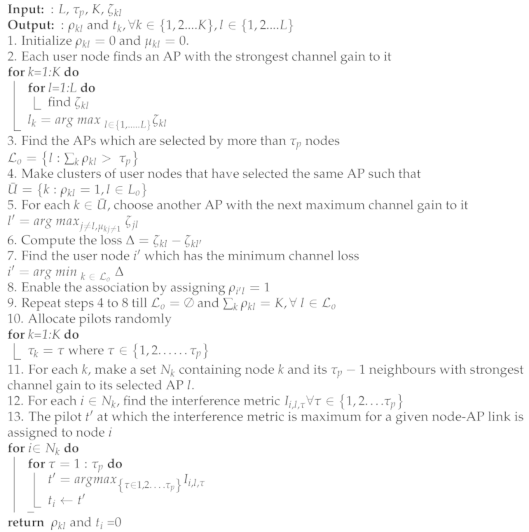 |
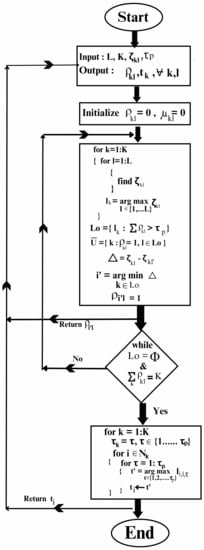
Figure 2.
Flowchart of the proposed algorithm.
4. Results and Discussion
The proposed cell-free network with an expanded IoT framework is modelled in a MATLAB simulation environment [55]. The results of the performance evaluation are presented in this section. The simulation model considers deployment of large number of APs in a given area of 1 km × 1 km to give service to massive user nodes. The APs are installed with uniform linear array. The size of the array is . The model considers a 3GPP microcell urban scenario with propagation parameters listed in Table 2. In the proposed model, an interference-aware scheduling scheme is presented whose performance evaluation is also carried out under different conditions. The performance parameters used for the evaluation of the proposed model include the number of connected nodes, number of APs, node locations, pilot length and spectral efficiency. The impact of different precoding schemes under different network operations on the performance is also investigated. A data or message flow diagram is presented in Figure 3.

Table 2.
Simulation parameters.
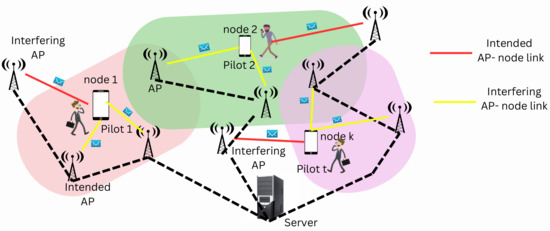
Figure 3.
Illustration of data or message flow in the proposed network model.
The performance of the proposed cell-free IoT network is quantified in Figure 4 for spectral efficiency achieved by the IoT nodes. The four precoding schemes are used under different cell-free operations. LPMMSE and MR precoding are used for distributed operation while PRZF and PMMSE are used for centralized operation. The comparison is evaluated in Figure 4 in which the cumulative distribution function (CDF) of the spectral efficiency in the downlink operation is plotted. The spectral efficiency obtained is 2.949 bits/s/Hz for MR precoding and 8.592 bits/s/Hz for scalable LPMMSE precoding. For the centralized operation, the PRZF and PMMSE precoding have similar performance, which gives 9.207 bits/s/Hz downlink spectral efficiency.
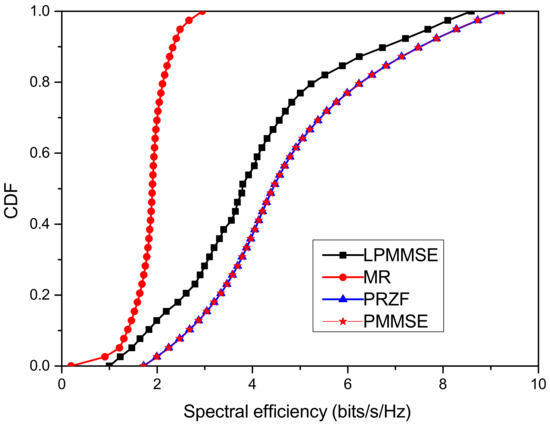
Figure 4.
CDF of spectral efficiency achieved with precoding schemes under different operations.
In the proposed model, the scheduling of nodes and serving APs is achieved using the proposed scheme, which takes into account the interference caused by the neighbouring nodes as well as the interfering APs. The CDF is obtained for the downlink operation to assess the performance of the proposed algorithm in Figure 5 for the precoding schemes defined in Section 2. The incorporation of proposed scheduling method, which facilitates optimal association of sensor nodes and the APs results in improved system performance. It has been observed that centralized precoding outperforms the LPMMSE and MR precoding achieving 18.9% improvement in achieved spectral efficiency with the proposed scheduling.
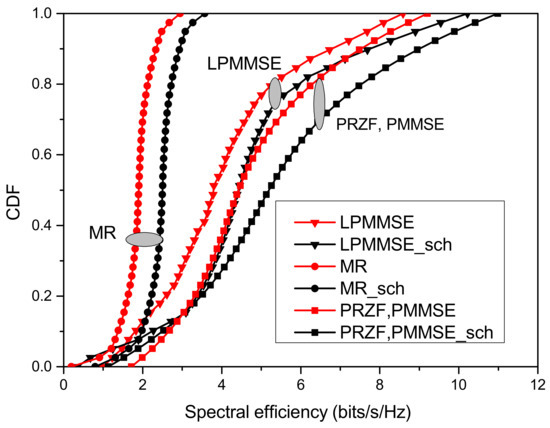
Figure 5.
Performance of proposed scheduling scheme for different precoding methods.
The communication model with proposed scheduling is compared with two other system models, one that is not incorporating any user-AP association and another that is using random scheduling to assign the nodes with the APs. The performance of these three models is depicted in Figure 6, which plots the spectral efficiency achieved by 95% of the communication nodes. As compared to random scheduling, the proposed scheduling shows improvement of 10.9% in obtained spectral efficiency with PRZF precoding. The system model with no scheduling incorporated, the 95% likely achieved spectral efficiency is minimum, which is 0.5789 bits/s/Hz with MR precoding, 1.1105 bits/s/Hz with LPMMSE precoding and 1.6869 bits/s/Hz with PRZF and PMMSE precoding. The variation of average spectral efficiency with number of nodes is shown in Figure 7. As the number of nodes are increased from 20 to 100, the average spectral efficiency is decreased to 1.69 bits/s/Hz in MR, 3.9 bits/s/Hz in LPMMSE and 4.799 bits/s/Hz in the PRZF precoding scheme. The impact of pilot length on the average spectral efficiency of the system is obtained in Figure 8. The performance of different precoding schemes under different operations of the proposed cell-free model is evaluated with the scheduling schemes. It is observed that on increasing the pilot length, the spectral efficiency first increases and then it saturates. On increasing the pilot length, the interference is reduced resulting in improved spectral efficiency performance. The AP-node association is improved as more APs can serve each node. But a further increase in will lead to saturation as the transmission symbol length is reduced. Here also, the proposed scheduling method outperforms the random scheduling and no scheduling approaches being adopted in different system models, respectively. The maximum spectral efficiency of 8.712 bits/s/Hz is obtained with proposed scheduling algorithm and PRZF precoding scheme at .
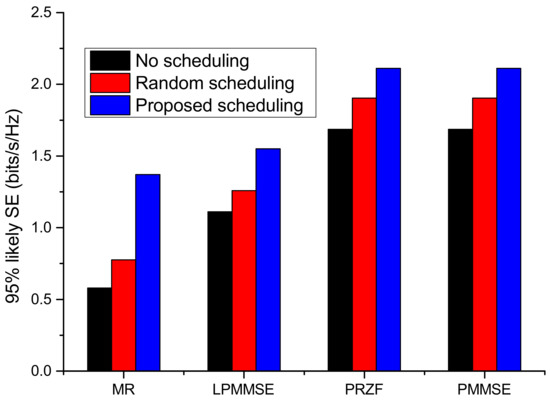
Figure 6.
The 95% likely spectral efficiency for different scheduling schemes.
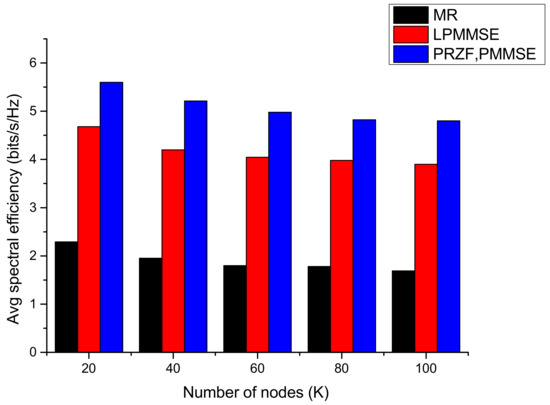
Figure 7.
Average spectral efficiency as a function of number of nodes.
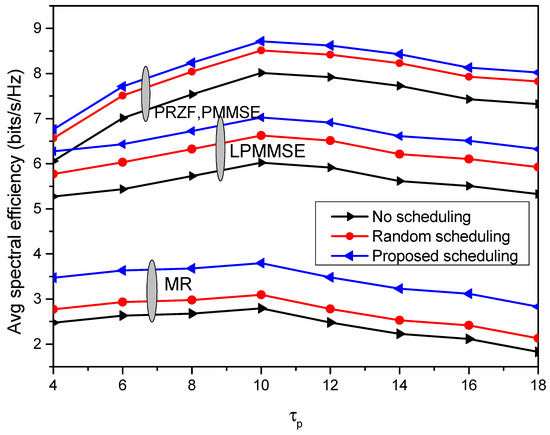
Figure 8.
Comparison of different scheduling methods under different pilot lengths.
5. Conclusions
Next generation IoT offers connected support to the consumers for personalized experience. The digital transformation of emerging consumer devices rely on future wireless technologies. In this paper, a 6G-enabled scalable cell-free IoT network is proposed that aims for uniform coverage to the nodes in the network. An interference-aware scheduling algorithm is proposed that enables optimal association of nodes and APs with robust interference management. The spectral efficiency performance is obtained for different precoding schemes under different cell-free operations. It is observed that the obtained value is 2.949 bits/s/Hz for MR precoding and 8.592 bits/s/Hz for scalable LPMMSE precoding. For the centralized operation, the PRZF and PMMSE precoding gives 9.207 bits/s/Hz downlink spectral efficiency. The centralized precoding outperforms the LPMMSE and MR precoding achieving 18.9% improvement with proposed scheduling. Further, the comparison with other system models reveals that as compared to random scheduling, the proposed scheduling shows improvement of 10.9% in obtained spectral efficiency by 95% of the user nodes with PRZF precoding. Also, the 95% likely achieved spectral efficiency is the minimum for the system model with no scheduling incorporated.
The energy efficiency analysis of the proposed cell-free network model with interference-aware scheduling is left for future work. The energy management of the network is necessary to support green communication in future IoT networks.
Author Contributions
Conceptualization, methodology: A.T., A.A. and N.A.; formal analysis: A.T., N.A. and A.A.; software, validation, writing—original draft: A.T. and N.A.; writing—review and editing: A.T., N.A. and A.A.; data curation: A.T., N.A. and A.A.; supervision, funding acquisition: N.A. and A.A. All authors have read and agreed to the published version of the manuscript.
Funding
The authors are thankful to the Deanship of Scientific Research at Najran University for funding this work under the Research Groups Funding program grant code (NU/RG/SERC/12/9).
Institutional Review Board Statement
Not applicable.
Informed Consent Statement
Not applicable.
Data Availability Statement
Not applicable.
Conflicts of Interest
The authors declare that they have no conflict of interest to report regarding the present study.
Abbreviations
The following abbreviations are used in this manuscript:
| 5G | Fifth generation |
| 6G | Sixth generation |
| IoT | Internet of Things |
| AP | Access points |
| UE | User equipment |
| CPU | Central processing unit |
| IRSs | Intelligent reflecting surfaces |
| MIMO | Multiple input multiple output |
| SWIPT | Simultaneous wireless information and power transfer |
| NMSE | Normalized mean square error |
| SE | Spectral efficiency |
| QoS | Quality of service |
| SINR | Signal-to-noise-plus-interference ratio |
| CDF | Cumulative distribution function |
| MR | Maximal ratio |
| PRZF | Partial regularized zero forcing |
| LPMMSE | Local partial minimum mean square error |
| PMMSE | Partial minimum mean square error |
References
- Vaezi, M.; Azari, A.; Khosravirad, S.R.; Shirvanimoghaddam, M.; Azari, M.M.; Chasaki, D.; Popovski, P. Cellular, Wide-Area, and Non-Terrestrial IoT: A Survey on 5G Advances and the Road Towards 6G. IEEE Commun. Surv. Tutor. 2022, 24, 1117–1174. [Google Scholar] [CrossRef]
- Nguyen, T.D.; Khan, J.Y.; Ngo, D.T. A Distributed Energy-Harvesting-Aware Routing Algorithm for Heterogeneous IoT Networks. IEEE Trans. Green Commun. Netw. 2018, 2, 1115–1127. [Google Scholar] [CrossRef]
- Albouq, S.S.; Sen, A.A.A.; Almashf, N.; Yamin, M.; Alshanqiti, A.; Bahbouh, N.M. A Survey of Interoperability Challenges and Solutions for Dealing With Them in IoT Environment. IEEE Access 2022, 10, 36416–36428. [Google Scholar] [CrossRef]
- Iqbal, W.; Abbas, H.; Daneshmand, M.; Rauf, B.; Bangash, Y.A. An In-Depth Analysis of IoT Security Requirements, Challenges, and Their Countermeasures via Software-Defined Security. IEEE Internet Things J. 2020, 7, 10250–10276. [Google Scholar] [CrossRef]
- Saluja, D.; Singh, R.; Saluja, N.; Kumar, S. Energy-efficient strategy for improving coverage and rate using hybrid vehicular networks. IEEE Trans. Intell. Transp. Syst. 2020, 23, 430–443. [Google Scholar] [CrossRef]
- Moya Osorio, D.P.; Ahmad, I.; Sánchez, J.D.V.; Gurtov, A.; Scholliers, J.; Kutila, M.; Porambage, P. Towards 6G-Enabled Internet of Vehicles: Security and Privacy. IEEE Open J. Commun. Soc. 2022, 3, 82–105. [Google Scholar] [CrossRef]
- Nekovee, M. Transformation from 5G for Verticals Towards a 6G-enabled Internet of Verticals. In Proceedings of the 2022 14th International Conference on COMmunication Systems NETworkS (COMSNETS), Bangalore, India, 4–8 January 2022; pp. 1–6. [Google Scholar] [CrossRef]
- Zhang, J.; Björnson, E.; Matthaiou, M.; Ng, D.W.K.; Yang, H.; Love, D.J. Prospective Multiple Antenna Technologies for Beyond 5G. IEEE J. Sel. Areas Commun. 2020, 38, 1637–1660. [Google Scholar] [CrossRef]
- Taneja, A.; Rani, S.; Alhudhaif, A.; Koundal, D.; Gündüz, E.S. An optimized scheme for energy efficient wireless communication via intelligent reflecting surfaces. Expert Syst. Appl. 2022, 190, 116106. [Google Scholar] [CrossRef]
- Zhang, Q.; Yang, H.H.; Quek, T.Q.S.; Lee, J. Heterogeneous Cellular Networks With LoS and NLoS Transmissions—The Role of Massive MIMO and Small Cells. IEEE Trans. Wirel. Commun. 2017, 16, 7996–8010. [Google Scholar] [CrossRef]
- Saluja, D.; Singh, R.; Saluja, N.; Kumar, S. Connectivity Improvement of Hybrid Millimeter Wave and Microwave Vehicular Networks. IEEE Trans. Intell. Transp. Syst. 2022, 24, 1456–1464. [Google Scholar] [CrossRef]
- Jiang, H.; Mukherjee, M.; Zhou, J.; Lloret, J. Channel Modeling and Characteristics for 6G Wireless Communications. IEEE Netw. 2021, 35, 296–303. [Google Scholar] [CrossRef]
- Wang, C.X.; Huang, J.; Wang, H.; Gao, X.; You, X.; Hao, Y. 6G Wireless Channel Measurements and Models: Trends and Challenges. IEEE Veh. Technol. Mag. 2020, 15, 22–32. [Google Scholar] [CrossRef]
- Jain, I.K.; Kumar, R.; Panwar, S.S. The Impact of Mobile Blockers on Millimeter Wave Cellular Systems. IEEE J. Sel. Areas Commun. 2019, 37, 854–868. [Google Scholar] [CrossRef]
- Zhang, J.; Dai, L.; Li, X.; Liu, Y.; Hanzo, L. On Low-Resolution ADCs in Practical 5G Millimeter-Wave Massive MIMO Systems. IEEE Commun. Mag. 2018, 56, 205–211. [Google Scholar] [CrossRef]
- Ammar, H.A.; Adve, R.; Shahbazpanahi, S.; Boudreau, G.; Srinivas, K.V. User-Centric Cell-Free Massive MIMO Networks: A Survey of Opportunities, Challenges and Solutions. IEEE Commun. Surv. Tutor. 2022, 24, 611–652. [Google Scholar] [CrossRef]
- Tan, L.; Zhang, Z.; Wang, D. Performance of Multiuser Downlink Cell-Free Massive MIMO Systems with Hard Deadlines. IEEE Access 2022, 10, 62910–62919. [Google Scholar] [CrossRef]
- Zhou, M.; Li, J.; Xie, M.; Zhang, C.; Yuan, J. Average Sum Rate of D2D Underlaid Multigroup Multicast Cell-Free Massive MIMO With Multi-Antenna Users. IEEE Wirel. Commun. Lett. 2023, 12, 60–64. [Google Scholar] [CrossRef]
- Chen, S.; Zhang, J.; Björnson, E.; Zhang, J.; Ai, B. Structured Massive Access for Scalable Cell-Free Massive MIMO Systems. IEEE J. Sel. Areas Commun. 2021, 39, 1086–1100. [Google Scholar] [CrossRef]
- Björnson, E.; Sanguinetti, L.; Wymeersch, H.; Hoydis, J.; Marzetta, T.L. Massive MIMO is a reality—What is next?: Five promising research directions for antenna arrays. Digit. Signal Process. 2019, 94, 3–20. [Google Scholar] [CrossRef]
- Björnson, E.; Hoydis, J.; Sanguinetti, L. Massive MIMO networks: Spectral, energy, and hardware efficiency. Found. Trends Signal Process. 2017, 11, 154–655. [Google Scholar] [CrossRef]
- Sanguinetti, L.; Björnson, E.; Hoydis, J. Toward Massive MIMO 2.0: Understanding Spatial Correlation, Interference Suppression, and Pilot Contamination. IEEE Trans. Commun. 2020, 68, 232–257. [Google Scholar] [CrossRef]
- Zhang, J.; Chen, S.; Lin, Y.; Zheng, J.; Ai, B.; Hanzo, L. Cell-Free Massive MIMO: A New Next-Generation Paradigm. IEEE Access 2019, 7, 99878–99888. [Google Scholar] [CrossRef]
- Buzzi, S.; D’Andrea, C.; Zappone, A.; D’Elia, C. User-Centric 5G Cellular Networks: Resource Allocation and Comparison With the Cell-Free Massive MIMO Approach. IEEE Trans. Wirel. Commun. 2020, 19, 1250–1264. [Google Scholar] [CrossRef]
- Balachandran, K.; Kang, J.H.; Karakayali, K.M.; Rege, K.M. Network-centric cooperation schemes for uplink interference management in cellular networks. Bell Labs Tech. J. 2013, 18, 23–36. [Google Scholar] [CrossRef]
- Peng, M.; Sun, Y.; Li, X.; Mao, Z.; Wang, C. Recent Advances in Cloud Radio Access Networks: System Architectures, Key Techniques, and Open Issues. IEEE Commun. Surv. Tutor. 2016, 18, 2282–2308. [Google Scholar] [CrossRef]
- Interdonato, G.; Frenger, P.; Larsson, E.G. Scalability Aspects of Cell-Free Massive MIMO. In Proceedings of the ICC 2019—2019 IEEE International Conference on Communications (ICC), Shanghai, China, 20–24 May 2019; pp. 1–6. [Google Scholar] [CrossRef]
- Chen, S.; Zhang, J.; Zhang, J.; Björnson, E.; Ai, B. A survey on user-centric cell-free massive MIMO systems. Digit. Commun. Netw. 2022, 8, 695–719. [Google Scholar] [CrossRef]
- Ngo, H.Q.; Ashikhmin, A.; Yang, H.; Larsson, E.G.; Marzetta, T.L. Cell-Free Massive MIMO Versus Small Cells. IEEE Trans. Wirel. Commun. 2017, 16, 1834–1850. [Google Scholar] [CrossRef]
- Mai, T.C.; Ngo, H.Q.; Duong, T.Q. Downlink Spectral Efficiency of Cell-Free Massive MIMO Systems With Multi-Antenna Users. IEEE Trans. Commun. 2020, 68, 4803–4815. [Google Scholar] [CrossRef]
- Burr, A.; Islam, S.; Zhao, J.; Bashar, M. Cell-free Massive MIMO with multi-antenna access points and user terminals. In Proceedings of the 2020 54th Asilomar Conference on Signals, Systems, and Computers, Pacific Grove, CA, USA, 1–4 November 2020; pp. 821–825. [Google Scholar] [CrossRef]
- Mai, T.C.; Quoc Ngo, H.; Duong, T.Q. Cell-free massive MIMO systems with multi-antenna users. In Proceedings of the 2018 IEEE Global Conference on Signal and Information Processing (GlobalSIP), Anaheim, CA, USA, 26–29 November 2018; pp. 828–832. [Google Scholar] [CrossRef]
- Yan, H.; Ashikhmin, A.; Yang, H. A Scalable and Energy-Efficient IoT System Supported by Cell-Free Massive MIMO. IEEE Internet Things J. 2021, 8, 14705–14718. [Google Scholar] [CrossRef]
- Chen, S.; Zhang, J.; Jin, Y.; Ai, B. Wireless powered IoE for 6G: Massive access meets scalable cell-free massive MIMO. China Commun. 2020, 17, 92–109. [Google Scholar] [CrossRef]
- Zhang, Y.; Xia, W.; Zhao, H.; Xu, W.; Wong, K.K.; Yang, L. Cell-Free IoT Networks with SWIPT: Performance Analysis and Power Control. IEEE Internet Things J. 2022, 9, 13780–13793. [Google Scholar] [CrossRef]
- Wang, H.; Wang, J.; Fang, J. Grant-Free Massive Connectivity in Massive MIMO Systems: Collocated Versus Cell-Free. IEEE Wirel. Commun. Lett. 2021, 10, 634–638. [Google Scholar] [CrossRef]
- Yang, H.; Marzetta, T.L. Energy Efficiency of Massive MIMO: Cell-Free vs. Cellular. In Proceedings of the 2018 IEEE 87th Vehicular Technology Conference (VTC Spring), Porto, Portugal, 3–6 June 2018; pp. 1–5. [Google Scholar] [CrossRef]
- Ngo, H.Q.; Tran, L.N.; Duong, T.Q.; Matthaiou, M.; Larsson, E.G. On the Total Energy Efficiency of Cell-Free Massive MIMO. IEEE Trans. Green Commun. Netw. 2018, 2, 25–39. [Google Scholar] [CrossRef]
- Nayebi, E.; Ashikhmin, A.; Marzetta, T.L.; Yang, H.; Rao, B.D. Precoding and Power Optimization in Cell-Free Massive MIMO Systems. IEEE Trans. Wirel. Commun. 2017, 16, 4445–4459. [Google Scholar] [CrossRef]
- Ngo, H.Q.; Tataria, H.; Matthaiou, M.; Jin, S.; Larsson, E.G. On the Performance of Cell-Free Massive MIMO in Ricean Fading. In Proceedings of the 2018 52nd Asilomar Conference on Signals, Systems, and Computers, Pacific Grove, CA, USA, 28–31 October 2018; pp. 980–984. [Google Scholar] [CrossRef]
- Özdogan, Ö.; Björnson, E.; Zhang, J. Performance of Cell-Free Massive MIMO With Rician Fading and Phase Shifts. IEEE Trans. Wirel. Commun. 2019, 18, 5299–5315. [Google Scholar] [CrossRef]
- Björnson, E.; Sanguinetti, L. A New Look at Cell-Free Massive MIMO: Making It Practical with Dynamic Cooperation. In Proceedings of the 2019 IEEE 30th Annual International Symposium on Personal, Indoor and Mobile Radio Communications (PIMRC), Istanbul, Turkey, 8–11 September 2019; pp. 1–6. [Google Scholar] [CrossRef]
- Björnson, E.; Sanguinetti, L. Making Cell-Free Massive MIMO Competitive with MMSE Processing and Centralized Implementation. IEEE Trans. Wirel. Commun. 2020, 19, 77–90. [Google Scholar] [CrossRef]
- Interdonato, G.; Karlsson, M.; Björnson, E.; Larsson, E.G. Local Partial Zero-Forcing Precoding for Cell-Free Massive MIMO. IEEE Trans. Wirel. Commun. 2020, 19, 4758–4774. [Google Scholar] [CrossRef]
- Nayebi, E.; Ashikhmin, A.; Marzetta, T.L.; Rao, B.D. Performance of cell-free massive MIMO systems with MMSE and LSFD receivers. In Proceedings of the 2016 50th Asilomar Conference on Signals, Systems and Computers, Pacific Grove, CA, USA, 6–9 November 2016; pp. 203–207. [Google Scholar] [CrossRef]
- Attarifar, M.; Abbasfar, A.; Lozano, A. Modified Conjugate Beamforming for Cell-Free Massive MIMO. IEEE Wirel. Commun. Lett. 2019, 8, 616–619. [Google Scholar] [CrossRef]
- Guenach, M.; Gorji, A.A.; Bourdoux, A. Joint Power Control and Access Point Scheduling in Fronthaul-Constrained Uplink Cell-Free Massive MIMO Systems. IEEE Trans. Commun. 2021, 69, 2709–2722. [Google Scholar] [CrossRef]
- Tang, J.; Liu, G.; Pan, Q. A Review on Representative Swarm Intelligence Algorithms for Solving Optimization Problems: Applications and Trends. IEEE/CAA J. Autom. Sin. 2021, 8, 1627–1643. [Google Scholar] [CrossRef]
- Tang, J.; Chen, X.; Zhu, X.; Zhu, F. Dynamic Reallocation Model of Multiple Unmanned Aerial Vehicle Tasks in Emergent Adjustment Scenarios. IEEE Trans. Aerosp. Electron. Syst. 2023, 59, 1139–1155. [Google Scholar] [CrossRef]
- 3GPP. Further Advancements for E-UTRA Physical Layer Aspects (Release 9). 3GPP Technical Specification 36.814. 2017. Available online: https://portal.3gpp.org/desktopmodules/Specifications/SpecificationDetails.aspx?specificationId=2493 (accessed on 25 March 2023).
- Taneja, A.; Saluja, N. Linear precoding with user and transmit antenna selection. Wirel. Pers. Commun. 2019, 109, 1631–1644. [Google Scholar] [CrossRef]
- Demir, Ö.T.; Björnson, E.; Sanguinetti, L. Foundations of user-centric cell-free massive MIMO. Found. Trends® Signal Process. 2021, 14, 162–472. [Google Scholar] [CrossRef]
- Ando, K.; Iimori, H.; Takahashi, T.; Ishibashi, K.; De Abreu, G.T.F. Uplink Signal Detection for Scalable Cell-Free Massive MIMO Systems With Robustness to Rate-Limited Fronthaul. IEEE Access 2021, 9, 102770–102782. [Google Scholar] [CrossRef]
- Bacha, M.; Di Renzo, M.; Clerckx, B. Treating Interference as Noise in Cellular Networks: A Stochastic Geometry Approach. IEEE Trans. Wirel. Commun. 2020, 19, 1918–1932. [Google Scholar] [CrossRef]
- The MathWorks Inc. MATLAB, version: 9.13.0 (R2022b); The MathWorks Inc.: Natick, MA, USA, 2022. [Google Scholar]
Disclaimer/Publisher’s Note: The statements, opinions and data contained in all publications are solely those of the individual author(s) and contributor(s) and not of MDPI and/or the editor(s). MDPI and/or the editor(s) disclaim responsibility for any injury to people or property resulting from any ideas, methods, instructions or products referred to in the content. |
© 2023 by the authors. Licensee MDPI, Basel, Switzerland. This article is an open access article distributed under the terms and conditions of the Creative Commons Attribution (CC BY) license (https://creativecommons.org/licenses/by/4.0/).